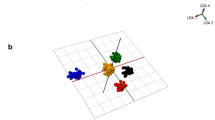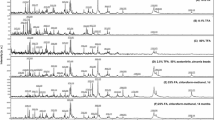Abstract
The topic of food analysis and safety has attracted increasing interest in recent decades owing to recent scandals concerning fraudulent activities (mislabeling, sophistication, adulteration, etc.) that can undermine human health. Among them, seafood fraud has probably the strongest relationship with food safety, an activity that goes beyond economic interests. This article explores the capabilities of an innovative instrumental setup, called the “iKnife,” as a powerful tool in this specific research area, where until now genomics and proteomics have been the workhorses in analytical approaches. iKnife, which means “intelligent knife,” is the name of a recent technology based on rapid evaporative ionization mass spectrometry (REIMS). REIMS is an emerging technique able to characterize different samples rapidly, affording a comprehensive profile usable as a fingerprint, without the need for preliminary extraction or cleanup procedures. In detail, a REIMS source is coupled to a high-resolution tandem mass spectrometer; such coupling allows one to maximize the amount of information (discriminant features) collected for a single analysis, as well as to focus on target analytes to achieve enhanced sensitivity and selectivity. A database was created from 18 marine species typical of the Mediterranean Sea, all caught in the very small area of the Strait of Messina, and reliable identification was achieved for each species with confidence higher than 99%. One big model and three submodels were built by principal component analysis and linear discriminant analysis for unambiguous key variable identification within each class (e.g., Cephalopoda), order (e.g., Perciformes), or family (e.g., Carangidae).

Graphical abstract






Similar content being viewed by others
References
Spink J, Moyer DC. Defining the public health threat of food fraud. J Food Sci. 2011;76:157–63.
Everstine K. Supply chain complexity and economically motivated adulteration. In: Shaun K, editor. Food protection and security. Cambridge: Woodhead; 2016.
Gormley R. Fish as a functional food. J Food Sci Technol. 2006;20:25–8.
Mori TA. Marine omega-3 fatty acids in the prevention of cardiovascular disease. Fitoterapia. 2017;123:51–8.
Sirot V, Oseredczuk M, Bemrah-Aouachria N, Volatier JL, Leblanc JC. Lipid and fatty acid composition of fish and seafood consumed in France: Calipso study. J Food Compos Anal. 2008;21:8–16.
Regulation (EU) No 1379/2013 of the European Parliament and of the Council of 11 December 2013 on the common organisation of the markets in fishery and aquaculture products, amending Council Regulations (EC) No 1184/2006 and (EC) No 1224/2009 and repealing Council Regulation (EC) No 104/2000. 2013. http://data.europa.eu/eli/reg/2013/1379/oj. Accessed 3 Dec 2018.
Council Regulation (EC) No 1005/2008 of 29 September 2008 establishing a community system to prevent, deter and eliminate illegal, unreported and unregulated fishing, amending Regulations (EEC) No 2847/93, (EC) No 1936/2001 and (EC) No 601/2004 and repealing Regulations (EC) No 1093/94 and (EC) No 1447/1999. 2008. http://data.europa.eu/eli/reg/2008/1005/oj. Accessed 3 Dec 2018.
Pardo MA, Jiménez E, Pérez-Villarreal B. Misdescription incidents in seafood sector. 2016;62:277–283.
Armani A, Castigliego L, Guidi A. Fish frauds: the DNA challenge. CAB Reviews. 2012;7:1–12.
Deceptive dishes: seafood swaps found worldwide. In: Oceana reports. 2016. https://usa.oceana.org/publications/reports/deceptive-dishes-seafood-swaps-found-worldwide. Accessed 3 Dec 2018.
FAO Fisheries and Aquaculture Department. The state of world fisheries and aquaculture. Rome: FAO; 2010. http://www.fao.org/docrep/013/i1820e/i1820e00.htm. Accessed 3 Dec 2018.
European Commission. The Rapid Alert System for Food and Feed 2017 annual report. Luxembourg: Publications Office of the European Union, 2018. https://ec.europa.eu/food/sites/food/files/safety/docs/rasff_annual_report_2017.pdf. Accessed 3 Dec 2018.
Worm B, Hilborn R, Baum JK, Branch TA, Collie JS, Costello C, et al. Rebuilding global fisheries. Science. 2009;325:578–84.
Risk assessment and control of IUU fishing for the marine insurance industry. In: Oceana reports. 2018. https://eu.oceana.org/en/publications/reports/risk-assessment-and-control-iuu-fishing-marine-insurance-industry. Accessed 3 Dec 2018.
Martinsohn JT, Geffen AJ, Maes GE, Nielsen EE, Ogden R, Waples RS, et al. Tracing fish and fish products from ocean to fork using advanced molecular technologies. In: Hoorfar J, Jordan K, Butler F, Prugger R, editors. Food chain integrity. Cambridge: Woodhead; 2011. p. 259–82.
Cabrero FMA, Hernández BC, Tango AM, Hillera DM, Marcos HJA. Outbreak due to butterfish consumption: keriorrhea and histamine poisoning. Rev Esp Salud Publica. 2015;89:99–105.
Warner K, Timme W, Lowell B, Hirshfield M. Oceana study reveals seafood fraud nationwide. In: Oceana reports. 2013. https://oceana.org/reports/oceana-study-reveals-seafood-fraud-nationwide. Accessed 28 Nov 2018.
Cutarelli A, Amoroso MG, De Roma A, Girardi S, Galiero G, Guarino A, et al. Italian market fish species identification and commercial frauds revealing by DNA sequencing. Food Control. 2014;37:46–50.
Teletchea F. Molecular identification methods of fish species: reassessment and possible applications. Rev Fish Biol Fish. 2009;19:265–93.
Jereb P, Roper CFE, Norman MK, Finn JK. Cephalopods of the world. An annotated and illustrated catalogue of cephalopod species known to date. Volume 3. Octopods and vampire squids. Rome: FAO; 2014.
Ittiobase. In: Istituto zooprofilattico sperimentale delle Venezie. https://www.izsvenezie.it/temi/tecnologia-innovazione/identificazione-di-specie-ittiche/. Accessed 12 Dec 2018.
Fishbase. In: http://www.fishbase.org. Accessed 12 Dec 2018.
Cubero-Leon E, Peñalver R, Maquet A. Review on metabolomics for food authentication. Food Res Int. 2014;60:95–107.
Trocino A, Xiccato G, Majolini D, Tazzoli M, Bertotto D, Pascoli F, et al. Assessing the quality of organic and conventionally-farmed European sea bass (Dicentrarchus labrax). Food Chem. 2012;131:427–33.
Black C, Chevallier OP, Elliott CT. The current and potential applications of ambient mass spectrometry in detecting food fraud. Trends Anal Chem. 2016;82:268–78.
Harris GA, Galhena AS, Fernández FM. Ambient sampling/ionization mass spectrometry: applications and current trends. Anal Chem. 2011;83:4508–38.
Phelps DL, Balog J, Gildea LF, Bodai Z, Savage A, El-Bahrawy MA, et al. The surgical intelligent knife distinguishes normal, borderline and malignant gynaecological tissues using rapid evaporative ionisation mass spectrometry (REIMS). Br J Cancer. 2018;118:1349–58.
Takats Z, Strittmatter N, McKenzie JS. Ambient mass spectrometry in cancer research. Adv Cancer Res. 2017;134:231–56.
Balog J, et al. Intraoperative tissue identification using rapid evaporative ionization. Sci Transl Med. 2013;194:1–11.
Golf O, Strittmatter N, Karancsi T, Pringle ST, Speller AVM, Mroz A, et al. Rapid evaporative ionization mass spectrometry imaging platform for direct mapping from bulk tissue and bacterial growth media. Anal Chem. 2015;87:2527–34.
Bolt F, Cameron SJS, Karancsi T, Simon D, Schaffer R, Rickards T, et al. Automated high-throughput identification and characterization of clinically important bacteria and fungi using rapid evaporative ionization mass spectrometry. Anal Chem. 2016;88:9419–26.
Bardin EE, Cameron SJS, Perdones-Montero A, Hardiman K, Bolt F, Alton EWFW, et al. Metabolic phenotyping and strain characterisation of Pseudomonas aeruginosa isolates from cystic fibrosis patients using rapid evaporative ionisation mass spectrometry. Sci Rep. 2018;8:1–10.
Balog J, Perenyi D, Guallar-Hoyas C, Egri A, Pringle SD, Stead S, et al. Identification of the species of origin for meat products by rapid evaporative ionization mass spectrometry. J Agric Food Chem. 2016;64:4793–800.
Black C, Chevallier OP, Haughey SA, Balog J, Stead S, Pringle SD, et al. A real time metabolomic profiling approach to detecting fish fraud using rapid evaporative ionisation mass spectrometry. Metabolomics. 2017;13:1–13.
Verplanken K, Stead S, Jandova R, Van Poucke C, Claereboudt J, Vanden Bussche J, et al. Rapid evaporative ionization mass spectrometry for high-throughput screening in food analysis: the case of boar taint. Talanta. 2017;169:30–6.
Rigano F, Stead S, Mangraviti D, Jandova R, Davy P, Marino N, et al. Use of an “intelligent knife” (iknife), based on the rapid evaporative ionization mass spectrometry technology, for authenticity assessment of pistachio samples. Food Anal Methods. 2019;12:558–68.
Coll M, Piroddi C, Steenbeek J, Kaschner K, Lasram FBR, Aguzzi J, et al. The biodiversity of the Mediterranean Sea: estimates, patterns, and threats. PLoS One. 2010;5:1–36.
European Market Observatory for Fisheries and Aquaculture Products. The EU fish market 2016 edition. 2016. https://www.eumofa.eu/documents/20178/77960/The+EU+fish+market+-+2016+Edition.pdf. Accessed 29 Nov 2018.
Council Regulation (EC) No 1967/2006 of 21 December 2006 concerning management measures for the sustainable exploitation of fishery resources in the Mediterranean Sea, amending Regulation (EEC) No 2847/93 and repealing Regulation (EC) No 1626/94. 2006. https://publications.europa.eu/en/publication-detail/-/publication/cb03e400-7e9d-4d84-8394-3c4283e3b35b/language-it. Accessed 30 Nov 2018.
Too cheap to be true: seafood fraud in Brussels. In: Oceana factsheet, November 2015. Oceana EU. 2015. https://eu.oceana.org/sites/default/files/421/oceana_factsheet_seafood_fraud_brussels_eng.pdf. Accessed 30 Nov 2018
Mahalanobis PC. On the generalized distance in statistics. proceedings of the national institute of science of India. 1936;2:49–55.
Ardura A, Planes S, Garcia-Vazquez E. Beyond biodiversity: fish metagenomes. PLoS One. 2011;6:1–7.
Arslan M, İşmen A. Age, growth and reproduction of Mullus surmuletus (Linnaeus, 1758) in Saros Bay (Northern Aegean Sea). J Black Sea Mediterr Environ. 2013;19:217–33.
Sala E, Ballesteros E. Partitioning of space and food resources by three fish of the genus Diplodus (Sparidae) in a Mediterranean rocky infralittoral ecosystem. Mar Ecol Prog Ser. 1997;152:273–83.
Regulation (EU) 2017/2107 of the European Parliament and of the Council of 15 November 2017 laying down management, conservation and control measures applicable in the convention area of the International Commission for the Conservation of Atlantic Tunas (ICCAT), and amending Council Regulations (EC) No 1936/2001, (EC) No 1984/2003 and (EC) No 520/2007. 2017. https://eur-lex.europa.eu/legal-content/EN/TXT/PDF/?uri=OJ:L:2017:315:FULL&from=IT. Accessed 30 Nov 2018.
Recommendation by ICCAT replacing the Recommendation [13-04] and establishing a multi-annual recovery plan for Mediterranean swordfish. In: International Commission for the conservation of Atlantic tunas. 2016. https://www.iccat.int/en/Inspection.html#. Accessed 30 Nov 2018.
Herrero B, Lago FC, Vieites JM, Espiñeira M. Development of a rapid and simple molecular identification methodology for true sardines (Sardina pilchardus) and false sardines (Sardinella aurita) based on the real-time PCR technique. Eur Food Res Technol. 2011;233:851–7.
Author information
Authors and Affiliations
Corresponding author
Ethics declarations
Conflict of interest
The authors declare that they have no conflicts of interest.
Statement of human and animal rights
All applicable international, national, and/or institutional guidelines for the care and use of animals were followed. All procedures were in accordance with guidelines for the protection of animal welfare, in compliance with Directive 2010/63/EU, which updates and replaces the 1986 Directive 86/609/EEC on the protection of animals used for scientific purposes.
Additional information
Publisher’s note
Springer Nature remains neutral with regard to jurisdictional claims in published maps and institutional affiliations.
ABC Highlights: authored by Rising Stars and Top Experts.
Electronic supplementary material
ESM 1
(PDF 10 MB)
Rights and permissions
About this article
Cite this article
Rigano, F., Mangraviti, D., Stead, S. et al. Rapid evaporative ionization mass spectrometry coupled with an electrosurgical knife for the rapid identification of Mediterranean Sea species. Anal Bioanal Chem 411, 6603–6614 (2019). https://doi.org/10.1007/s00216-019-02000-z
Received:
Revised:
Accepted:
Published:
Issue Date:
DOI: https://doi.org/10.1007/s00216-019-02000-z




